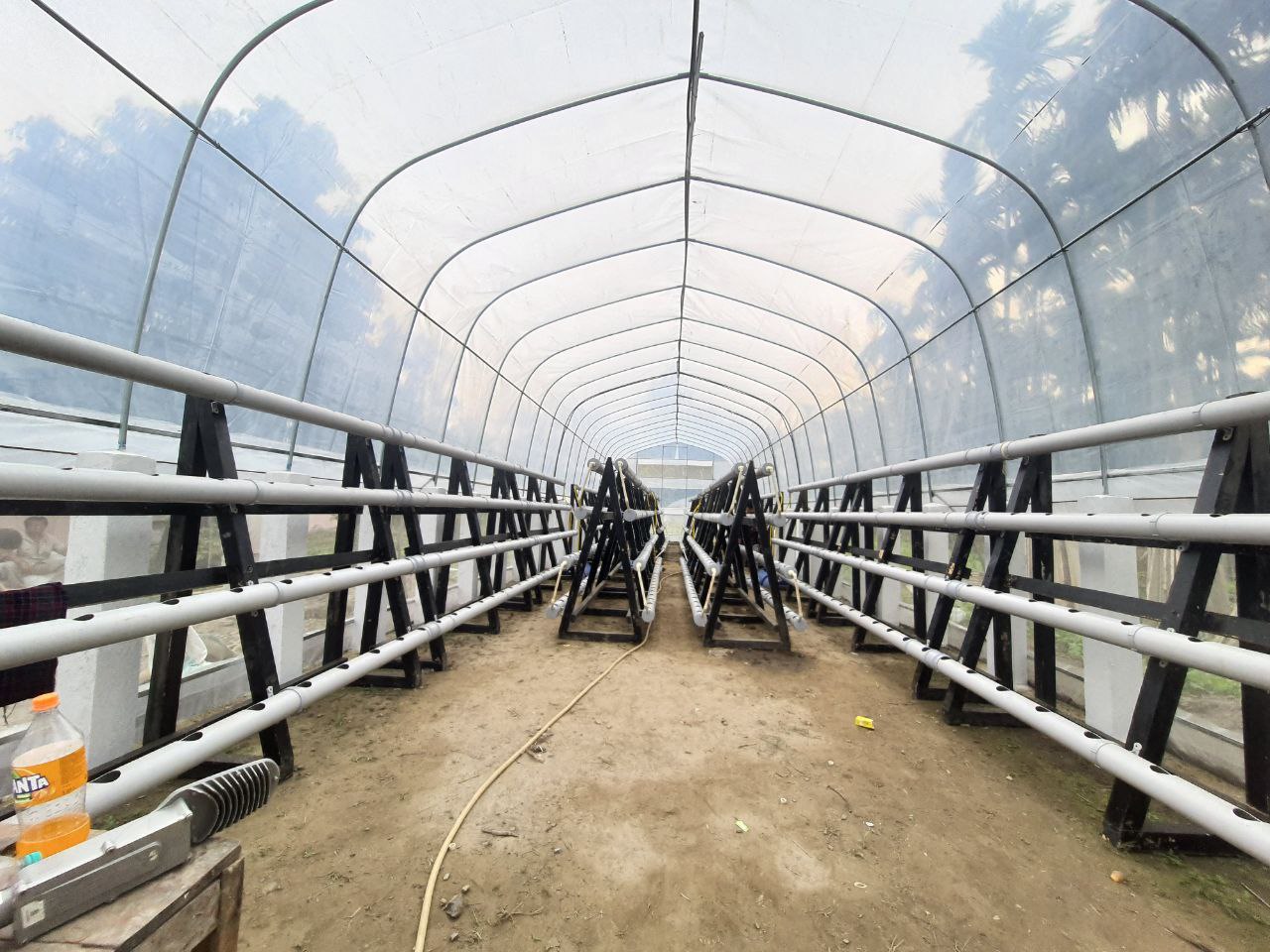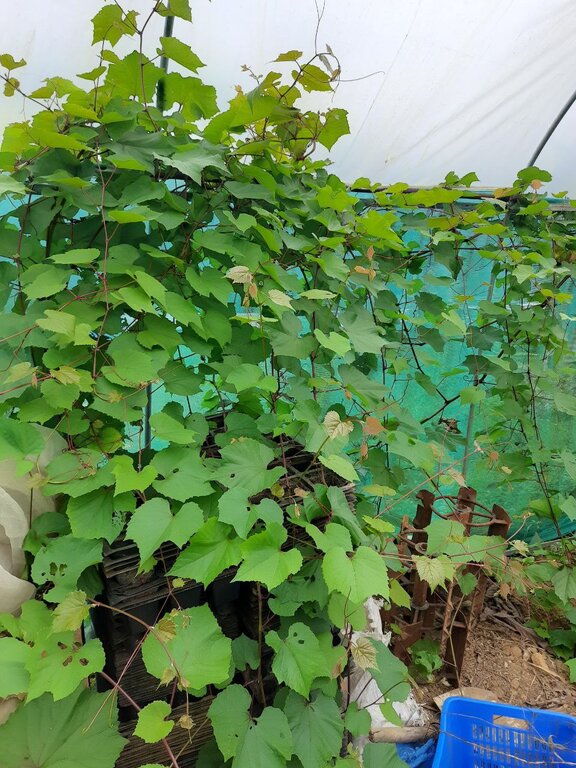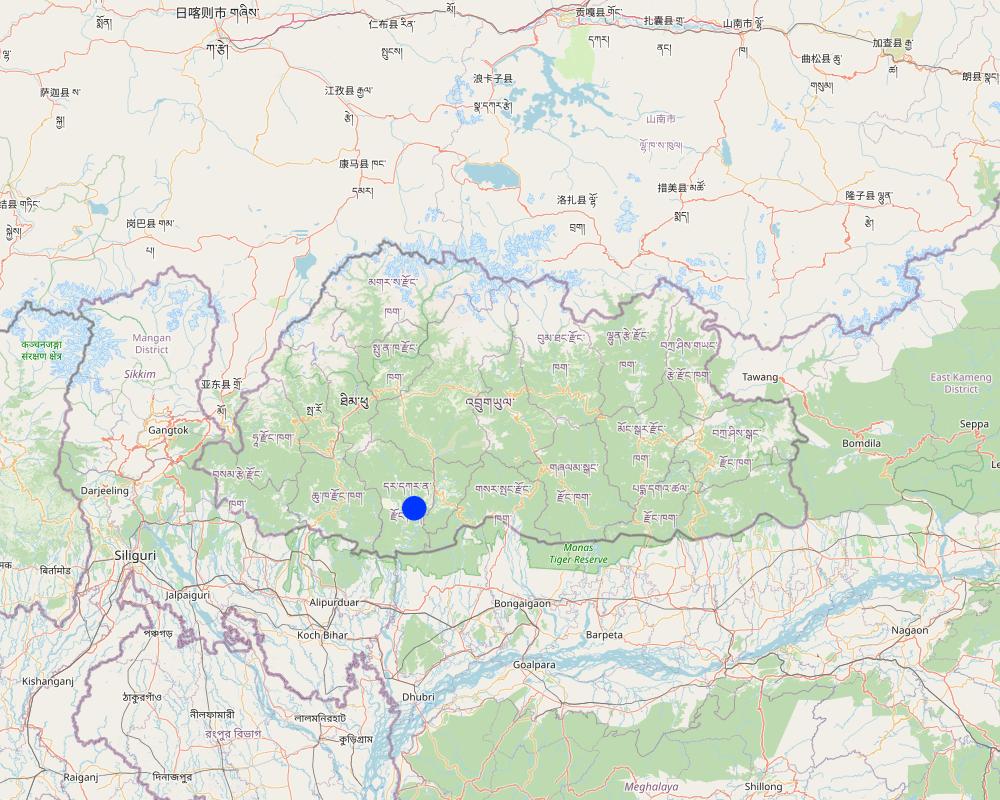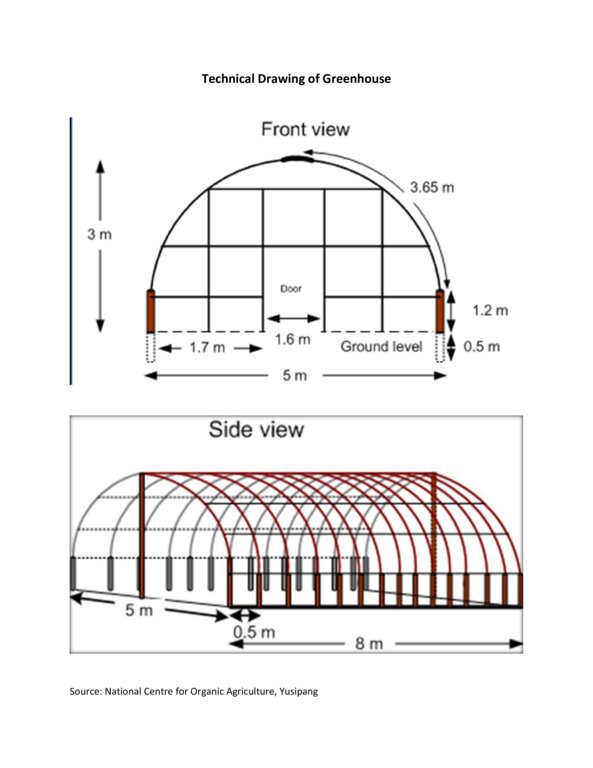Protected Agriculture for High Value Crops [不丹]
- 创建:
- 更新:
- 编制者: Nima Dolma Tamang
- 编辑者: Haka Drukpa
- 审查者: William Critchley, Rima Mekdaschi Studer
technologies_6846 - 不丹
查看章节
全部展开 全部收起1. 一般信息
1.2 参与该技术评估和文件编制的资源人员和机构的联系方式
关键资源人
土地使用者:
Narayan Abi
Abimanyum Farm
不丹
有助于对技术进行记录/评估的项目名称(如相关)
Strengthening national-level institutional and professional capacities of country Parties towards enhanced UNCCD monitoring and reporting – GEF 7 EA Umbrella II (GEF 7 UNCCD Enabling Activities_Umbrella II)有助于对技术进行记录/评估的机构名称(如相关)
National Soil Services Centre, Department of Agriculture, Ministry of Agriculture & Livestock (NSSC) - 不丹1.3 关于使用通过WOCAT记录的数据的条件
编制者和关键资源人员接受有关使用通过WOCAT记录数据的条件。:
是
1.4 所述技术的可持续性声明
这里所描述的技术在土地退化方面是否存在问题,导致无法被认为是一种可持续的土地管理技术?:
否
1.5 参考关于SLM方法(使用WOCAT记录的SLM方法)的调查问卷
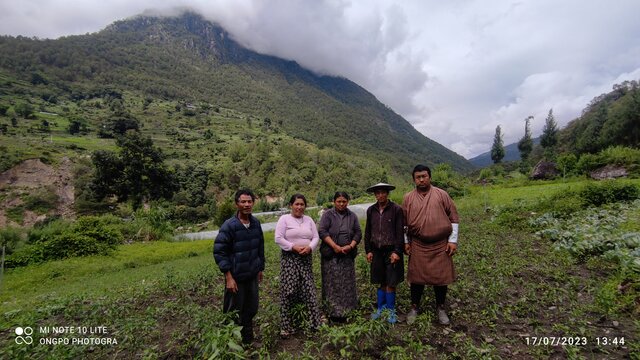
Enhancing Agricultural Production Through Fallow Land Reversion [不丹]
The approach is to enhance production of local vegetables and fruits through fallow land restoration - under a group established for the purpose.
- 编制者: Nima Dolma Tamang
2. SLM技术的说明
2.1 技术简介
技术定义:
Protected agriculture (controlled environment agriculture) is the use of technology to modify the growing environment for crops to extend the growing period and increase yields. It can include greenhouses, shade nets or polytunnels. This technology is moderately expensive therefore it is used only for the cultivation of high-value crops and raising seedlings in winter.
2.2 技术的详细说明
说明:
Protected agriculture, also known as controlled environment agriculture, refers to the practice of growing crops within an enclosed structure that provides controlled environmental conditions. There are various structures that can be employed, such as greenhouses, shade nets, polytunnels and glasshouses. This documentation focuses on greenhouses. These are commonly used for cultivating high-value crops that yield a higher economic return per unit area compared to traditional field crops. Technical specification for a 20 m x 5 m greenhouse set consists of a galvanized tubular frame, two doors, UV stabilized 120 GSM cross-laminated clear plastic sheet, channels and a nylon belt for holding the plastic sheet. Construction activities include clearing, levelling the ground and ensuring drainage. Installation of water lines, electrical connections, heating systems and ventilation systems is required.
Greenhouses are typically designed with a framework made of materials like metal, wood, or PVC. The structure must be sturdy enough to support covering materials and withstand environmental loads such as wind and snow. Coverings are transparent or translucent materials that allow sunlight to enter the structure. Common options include glass, polycarbonate panels, or plastic film. The choice of covering material depends on factors such as light transmission, insulation properties, durability, and cost. Greenhouses require adequate ventilation to control temperature, humidity, and air circulation. Vents, louvres, or roll-up side walls can be used to regulate airflow and prevent heat buildup. Exhaust fans or natural ventilation methods help remove excess heat, humidity, and carbon dioxide from the structure. Efficient irrigation systems, such as drip irrigation, and micro-sprinklers, are used to deliver water directly to plants' root zones. Raised beds of 1.2 m width and 30 cm height and planting distance of 60 cm are applied for (for example) watermelon.
Greenhouses allow for the cultivation of plants throughout the year, regardless of the external weather. By maintaining a stable and favourable climate inside, growers can start plants earlier in the spring, extend the growing season into the fall, or even grow plants year-round in certain regions. It shields plants from adverse weather conditions such as frost, heavy rain, wind, or hail, which can damage or destroy crops. Greenhouses provide a physical barrier that safeguards plants from external threats, minimizing the risk of disease, pests, and other environmental stresses.
Greenhouses provide a range of benefits and impacts, including increased food production by extending the growing season and improving food security. They produce higher crop yields by providing optimal growing conditions and conserving water through efficient irrigation systems. Greenhouses also contributes to reduced pesticide use, energy efficiency, local and seasonal produce, employment opportunities, research and innovation, and serves as an attractive space for recreation and education. Overall, greenhouses offer sustainable and efficient solutions for agriculture while enhancing environmental stewardship and community well-being.
Protected agriculture through the use of greenhouses offers land users the ability to control environmental factors, leading to optimal conditions for plant growth and higher crop yields compared to open-field cultivation. It protects from adverse weather conditions, reducing crop losses due to frost, rain, or wind. Additionally, the controlled environment minimizes the risk of pests and diseases, resulting in fewer losses and reduced reliance on pesticides. Overall, greenhouses enhance productivity, profitability, and sustainability for land users. On the other hand, setting up a greenhouse requires a significant initial investment, including the construction or purchase of the structure, equipment, and environmental control systems. Operating a greenhouse involves ongoing costs for utilities, maintenance, and replacement of equipment, which can impact profitability. The cost can be reduced by establishing a low cost greenhouse with locally available materials such as bamboo.
2.3 技术照片
2.4 技术视频
注释、简短说明:
https://www.youtu.be/i8izu3PmQRE
This link provides poly house construction basics video prepared by ARDC Bajo officials and JICA experts of Integrated Horticulture Promotion Project
日期:
01/11/2020
位置:
Agriculture Research and Development Sub Centre Tsirang
摄影师的名字:
JICA Experts and ARDC Bajo Officials
2.5 已应用该技术的、本评估所涵盖的国家/地区/地点
国家:
不丹
区域/州/省:
Dagana Dzongkhag
有关地点的进一步说明:
Tsendagang Gewog
具体说明该技术的分布:
- 适用于特定场所/集中在较小区域
技术现场是否位于永久保护区?:
否
注释:
It is leased land and does not fall under a permanently protected area.
Map
×2.6 实施日期
注明实施年份:
2020
2.7 技术介绍
- Through other farmers
3. SLM技术的分类
3.1 该技术的主要目的
- 改良生产
- 降低灾害风险
- 减缓气候变化及其影响
- 创造有益的经济影响
- To improve livelihood
3.2 应用该技术的当前土地利用类型
同一土地单元内混合使用的土地::
是
具体说明混合土地使用(作物/放牧/树木):
- 农林业

农田
- 一年一作
- 多年一作(非木材)
- 乔木与灌木的种植
年作 - 具体指明作物:
- 豆科牧草和豆类 - 豆子
- 蔬菜 - 香瓜、南瓜、南瓜或葫芦
- 蔬菜 - 其他
- Chilli
多年生(非木质)作物 - 指定作物:
- 香蕉/芭蕉/蕉麻
- 花卉作物 - 多年生
乔木和灌木种植 - 指定作物:
- 树坚果(巴西坚果、开心果、核桃、杏仁等)
每年的生长季节数:
- 2
采用间作制度了吗?:
是
如果是,说明哪些作物是间作的:
Watermelon and zucchini are intercropped
采用轮作制度了吗?:
是
如果是,请具体说明:
Watermelon is followed by chilli or beans cultivation on the same land
3.3 由于技术的实施,土地使用是否发生了变化?
由于技术的实施,土地使用是否发生了变化?:
- 是(请在技术实施前填写以下有关土地利用的问题)
同一土地单元内混合使用的土地::
否

森林/林地
- (半天然)天然森林/林地
- Natural forest
以上的树木是落叶树还是常绿树?:
- 常绿
注释:
The land is a cleared settlement from indigenous subtropical forest. Land use changed from subtropical forest to the agroforestry system where few native trees were retained with fruit trees and crops cultivated.
3.4 供水
该技术所应用土地的供水:
- 充分灌溉
注释:
Protected agriculture - especially greenhouses - depends on full irrigation with a drip irrigation system.
3.5 该技术所属的SLM组
- 轮作制度(轮作、休耕、轮垦)
- 改良植物品种/动物品种
- 灌溉管理(包括供水、排水)
3.6 包含该技术的可持续土地管理措施

农艺措施
- A1:植被和土壤覆盖层
- A2:有机质/土壤肥力

结构措施
- S1:阶地
- S11:其它

管理措施
- M1:改变土地使用类型
注释:
For the introduction of the technology, excavated or cut-and-fill bench terraces were built to install greenhouses.
3.7 该技术强调的主要土地退化类型

土壤水蚀
- Wt:表土流失/地表侵蚀

土壤风蚀
- Et:表土流失

生物性退化
- Bc:植被覆盖的减少
- Bp:害虫/疾病增加,捕食者减少

水质恶化
- Hs:地表水良变化
3.8 防止、减少或恢复土地退化
具体数量名该技术与土地退化有关的目标:
- 防止土地退化
4. 技术规范、实施活动、投入和成本
4.1 该技术的技术图纸
技术规范(与技术图纸相关):
The technical drawing provided is for the low-cost greenhouse (Made up of bamboo). Generally, the length of a commercial greenhouse is 10 or 20 m and the width of 5 m. The greenhouse can be modified based on the crop to be cultivated. Additional facilities such as drip irrigation set, blower, fan, cooling pad and exhaust fan, temperature sensors are added modify the environment.
作者:
National Centre for Organic Agriculture, Yusipang
技术规范(与技术图纸相关):
Technical details for setting up 5m by 20m double poly house protected structure
作者:
ARDC Bajo
日期:
01/07/2020
4.2 有关投入和成本计算的一般信息
具体说明成本和投入是如何计算的:
- 每个技术区域
注明尺寸和面积单位:
3.75 acres
其它/国家货币(具体说明):
Ngultrum (Nu.)
如相关,注明美元与当地货币的汇率(例如1美元=79.9巴西雷亚尔):1美元=:
79.0
注明雇用劳工的每日平均工资成本:
500
4.3 技术建立活动
| 活动 | 时间(季度) | |
|---|---|---|
| 1. | Clearing of vegetations | Winter |
| 2. | Agriculture land development | Winter |
| 3. | Field preparation | Winter |
| 4. | Installation of greenhouse and other structure | Winter |
| 5. | Sowing and plantation of crops and fruits (especially late winter crops) | Winter |
注释:
The installation of a greenhouse can be done in any season. However, the most preferred time for the installation is in winter when the crops standing in the field are minimal and the land users are not involved in other farming activities such as paddy cultivation.
4.4 技术建立所需要的费用和投入
| 对投入进行具体说明 | 单位 | 数量 | 单位成本 | 每项投入的总成本 | 土地使用者承担的成本% | |
|---|---|---|---|---|---|---|
| 劳动力 | Farm establishment | Number | 30.0 | 500.0 | 15000.0 | 100.0 |
| 劳动力 | Installation of structure and plantation | Number | 15.0 | 500.0 | 7500.0 | 100.0 |
| 设备 | Excavator (farm establishment) | Number of days | 12.0 | 24000.0 | 288000.0 | 100.0 |
| 设备 | Power tiller | Per hour | 16.0 | 250.0 | 4000.0 | 50.0 |
| 植物材料 | Dragon fruit | Per sapling | 300.0 | 50.0 | 15000.0 | |
| 植物材料 | Watermelon seed | Per packet | 1.0 | 2700.0 | 2700.0 | |
| 施工材料 | Greenhouse | Number | 6.0 | 80000.0 | 480000.0 | 20.0 |
| 施工材料 | Dragon fruit staking | Number | 39.0 | 700.0 | 27300.0 | 100.0 |
| 技术建立所需总成本 | 839500.0 | |||||
| 技术建立总成本,美元 | 10626.58 | |||||
如果土地使用者负担的费用少于100%,请注明由谁负担其余费用:
Royal Government of Bhutan (RGoB)
注释:
For a greenhouse it costs Nu. 80000. Therefore, the total cost of six green houses that are available at the farm is Nu. 480000 (USD 5790). For the greenhouse, 80% is borne by the RGoB. However, for the overall establishment major costs were borne by the land user and a minimal cost was part of the subsidy/fund support from RGoB as shown in the table above. The land user has 4.9 acre of which 3.75 acre is cultivated and 0.11 acre is under protected agriculture.
4.5 维护/经常性活动
注释:
The land user haven't carry out any maintenance due to the recent establishment of the farm. However, there is likely to have a maintenance cost of Nu. 5000 (USD 289) for the greenhouses and overall recurrent cost of Nu. 41975 (USD 506) per annum.
4.6 维护/经常性活动所需要的费用和投入(每年)
注释:
No maintenance has been carried out
4.7 影响成本的最重要因素
描述影响成本的最决定性因素:
Infrastructure and machinery.
5. 自然和人文环境
5.1 气候
年降雨量
- < 250毫米
- 251-500毫米
- 501-750毫米
- 751-1,000毫米
- 1,001-1,500毫米
- 1,501-2,000毫米
- 2,001-3,000毫米
- 3,001-4,000毫米
- > 4,000毫米
农业气候带
- 半湿润
The area falls under a humid subtropical and warm subtropical zone among the six agro-ecological zones of Bhutan.
5.2 地形
平均坡度:
- 水平(0-2%)
- 缓降(3-5%)
- 平缓(6-10%)
- 滚坡(11-15%)
- 崎岖(16-30%)
- 陡峭(31-60%)
- 非常陡峭(>60%)
地形:
- 高原/平原
- 山脊
- 山坡
- 山地斜坡
- 麓坡
- 谷底
垂直分布带:
- 0-100 m a.s.l.
- 101-500 m a.s.l.
- 501-1,000 m a.s.l.
- 1,001-1,500 m a.s.l.
- 1,501-2,000 m a.s.l.
- 2,001-2,500 m a.s.l.
- 2,501-3,000 m a.s.l.
- 3,001-4,000 m a.s.l.
- > 4,000 m a.s.l.
说明该技术是否专门应用于:
- 不相关
5.3 土壤
平均土层深度:
- 非常浅(0-20厘米)
- 浅(21-50厘米)
- 中等深度(51-80厘米)
- 深(81-120厘米)
- 非常深(> 120厘米)
土壤质地(表土):
- 粗粒/轻(砂质)
土壤质地(地表以下> 20厘米):
- 粗粒/轻(砂质)
表土有机质:
- 高(>3%)
如有可能,附上完整的土壤描述或具体说明可用的信息,例如土壤类型、土壤酸碱度、阳离子交换能力、氮、盐度等。:
Moisture content 3.31%, organic matter 5.03%, organic carbon 2.92%, pH 5.67, electrical conductivity 337.67 µs/cm, nitrogen 0.15%, phosphorus 0.09 ppm, potassium 123.07 mg/100ml, texture sand clay loam.
The soil analysis was conducted at the Science Laboratory of College of Natural Resources, Royal University of Bhutan, Lobesa, Punakha.
The soil data shared under the section 5.2 is for the growing media used inside the greenhouse. Land user adds organic manure to the existing topsoil which is used as a growing media.
5.4 水资源可用性和质量
地表水的可用性:
中等
水质(未处理):
不良饮用水(需要处理)
水质请参考::
地表水
水的盐度有问题吗?:
否
该区域正在发生洪水吗?:
否
关于水质和水量的注释和进一步规范:
There is a water shortage during the winter season.
5.5 生物多样性
物种多样性:
- 中等
栖息地多样性:
- 中等
关于生物多样性的注释和进一步规范:
The species and habitat diversity in the questions above are referred to the farm and not inside the greenhouse.
5.6 应用该技术的土地使用者的特征
定栖或游牧:
- 定栖的
生产系统的市场定位:
- 商业/市场
非农收入:
- 低于全部收入的10%
相对财富水平:
- 平均水平
个人或集体:
- 个人/家庭
机械化水平:
- 机械化/电动
性别:
- 男人
土地使用者的年龄:
- 中年人
5.7 应用该技术的土地使用者使用的平均土地面积
- < 0.5 公顷
- 0.5-1 公顷
- 1-2 公顷
- 2-5公顷
- 5-15公顷
- 15-50公顷
- 50-100公顷
- 100-500公顷
- 500-1,000公顷
- 1,000-10,000公顷
- > 10,000公顷
这被认为是小规模、中规模还是大规模的(参照当地实际情况)?:
- 大规模的
注释:
The land user has 4.9 acres of which 3.75 acres are cultivated. The average land holding in Bhutan is 3.4 acres, therefore the land users owning/farming more than 3.4 acres are categorized as large-scale.
5.8 土地所有权、土地使用权和水使用权
土地所有权:
- 个人,未命名
土地使用权:
- 租赁
用水权:
- 社区(有组织)
土地使用权是否基于传统的法律制度?:
是
具体说明:
Land leasing is a traditional legal system where the land user has a contract with the owner for 20 years. After the completion of the contract term, the land and the infrastructures are to be handed to the land owner.
5.9 进入服务和基础设施的通道
健康:
- 贫瘠
- 适度的
- 好
教育:
- 贫瘠
- 适度的
- 好
技术援助:
- 贫瘠
- 适度的
- 好
就业(例如非农):
- 贫瘠
- 适度的
- 好
市场:
- 贫瘠
- 适度的
- 好
能源:
- 贫瘠
- 适度的
- 好
道路和交通:
- 贫瘠
- 适度的
- 好
饮用水和卫生设施:
- 贫瘠
- 适度的
- 好
金融服务:
- 贫瘠
- 适度的
- 好
6. 影响和结论性说明
6.1 该技术的现场影响
社会经济效应
生产
作物生产
注释/具体说明:
Compared to open fields, protected agriculture has shown an increase in production. This could be due to the extended growing period, reduced disease incidence and ease of performing cultural activities.
作物质量
注释/具体说明:
The crop quality is improved in the protected agriculture as the optimum environmental conditions are provided.
生产故障风险
注释/具体说明:
The risk of production failure is reduced as the crop is not exposed to abiotic stress.
土地管理
SLM之前的数量:
10%
SLM之后的数量:
20%
注释/具体说明:
Land management in the protected cultivation is easier compared to open field.
收入和成本
农业投入费用
SLM之前的数量:
0%
SLM之后的数量:
10%
注释/具体说明:
Initial investment for the establishment of the protected structure is high. However, the expenses on agricultural inputs were reduced after establishment. Further, the initial negative expenses are compensated by the return from selling the farm produce.
农业收入
SLM之前的数量:
20%
SLM之后的数量:
70%
注释/具体说明:
There is a significant increase in the farm income after the establishment of the protected structure as the quantity and the quality of the high-value crops increased fetching higher prices. This has led to an increase in farm income.
工作量
注释/具体说明:
The workload has reduced after the establishment of the greenhouse. For example, the greenhouse is equipped with a drip irrigation system in which the land users can regulate the irrigation frequency and need not water the plants manually.
社会文化影响
食品安全/自给自足
SLM之前的数量:
20%
SLM之后的数量:
80%
注释/具体说明:
The increase in agricultural production has made the land user self-sufficient in certain fruits and vegetables. The technology has also contributed to the food security of the farm household as the income generated from the farm can be used to purchase nutritious foods that are not available on the farm.
6.2 该技术的场外影响已经显现
水资源可用性
注释/具体说明:
Unlike flooding irrigation in open fields which requires a large amount of water, a protected structure optimizes water usage. It is achieved by drip irrigation and manual irrigation leading to minimum water wastage. This increases water availability on other parts of the farm or for the community.
6.3 技术对渐变气候以及与气候相关的极端情况/灾害的暴露和敏感性(土地使用者认为的极端情况/灾害)
渐变气候
渐变气候
| 季节 | 增加或减少 | 该技术是如何应对的? | |
|---|---|---|---|
| 年温度 | 增加 | 非常好 | |
| 年降雨量 | 增加 | 非常好 | |
| 季雨量 | 夏季 | 增加 | 非常好 |
气候有关的极端情况(灾害)
生物灾害
| 该技术是如何应对的? | |
|---|---|
| 流行病 | 非常好 |
| 昆虫/蠕虫侵扰 | 好 |
6.4 成本效益分析
技术收益与技术建立成本相比如何(从土地使用者的角度看)?
短期回报:
非常消极
长期回报:
积极
技术收益与技术维护成本/经常性成本相比如何(从土地使用者的角度看)?
短期回报:
中性/平衡
长期回报:
非常积极
6.5 技术采用
- 11-50%
在所有采用这项技术的人当中,有多少人是自发的,即未获得任何物质奖励/付款?:
- 0-10%
6.6 适应
最近是否对该技术进行了修改以适应不断变化的条件?:
否
6.7 该技术的优点/长处/机会
| 土地使用者眼中的长处/优势/机会 |
|---|
| Improved market access. Protected structures enable off-season cultivation of certain high-value crops such as chilli and beans leading to higher market access and increased income. |
| Reduced pest and disease incidence. This could be due to optimum growing conditions provided to the plant and ease of pest and disease management. For example, the land user can remove a part of the plant that is infested or remove the crop that is infested in the particular greenhouse and still obtain the yield from other greenhouses. This is not possible in the open field condition. |
| Improved quality of the crops. The environmental conditions inside the greenhouse can be maintained at the optimum level required by plants leading to better quality produce. |
| 编制者或其他关键资源人员认为的长处/优势/机会 |
|---|
| Reduced workload. After the establishment of the protected structure, there is less workforce required for the cultivation. |
| Increased production. The land users can extend the growing period in the enclosed structure which leads to increased cropping season per year maximizing agricultural production. |
6.8 技术的弱点/缺点/风险及其克服方法
| 土地使用者认为的弱点/缺点/风险 | 如何克服它们? |
|---|---|
| The establishment of the technology has high initial investment. | Getting loans from financial institutions and sourcing fund from the government. |
| The farm is challenged with labour shortage. | Increasing the daily wage of labour and providing necessary facilities such as clean drinking water, washing and toilet facilities and providing incentives to retain them. |
| Difficult to manage the farm. | Improving record keeping, developing farm calendar and scheduling activities. |
7. 参考和链接
7.1 信息的方法/来源
- 实地考察、实地调查
One
- 与土地使用者的访谈
One
(现场)数据是什么时候汇编的?:
12/07/2023
7.2 参考可用出版物
标题、作者、年份、ISBN:
ARDC Wengkhar. (2017). Activity completion report for CARELP support to ARDC-Wengkhar.
可以从哪里获得?成本如何?
https://www.google.com/url?sa=t&source=web&rct=j&opi=89978449&url=https://www.carlep.gov.bt/wp-content/uploads/2016/11/Activity-Completion-Report-2016_17_CARLEP-Support-to-ARDC-wengkhar_FINAL.pdf&ved=2ahUKEwi3wZSPj_CAAxUB3TgGHTh_A0cQFnoECBEQAQ&usg=AOvVaw3lsXjKzuaScR91V1MntyJZ
7.3 链接到网络上的相关信息
标题/说明:
Polyhouse Construction Basics in Bhutan (Dzongkha language)
URL:
https://www.youtube.com/watch?app=desktop&v=i8izu3PmQRE
链接和模块
全部展开 全部收起链接

Enhancing Agricultural Production Through Fallow Land Reversion [不丹]
The approach is to enhance production of local vegetables and fruits through fallow land restoration - under a group established for the purpose.
- 编制者: Nima Dolma Tamang
模块
无模块


